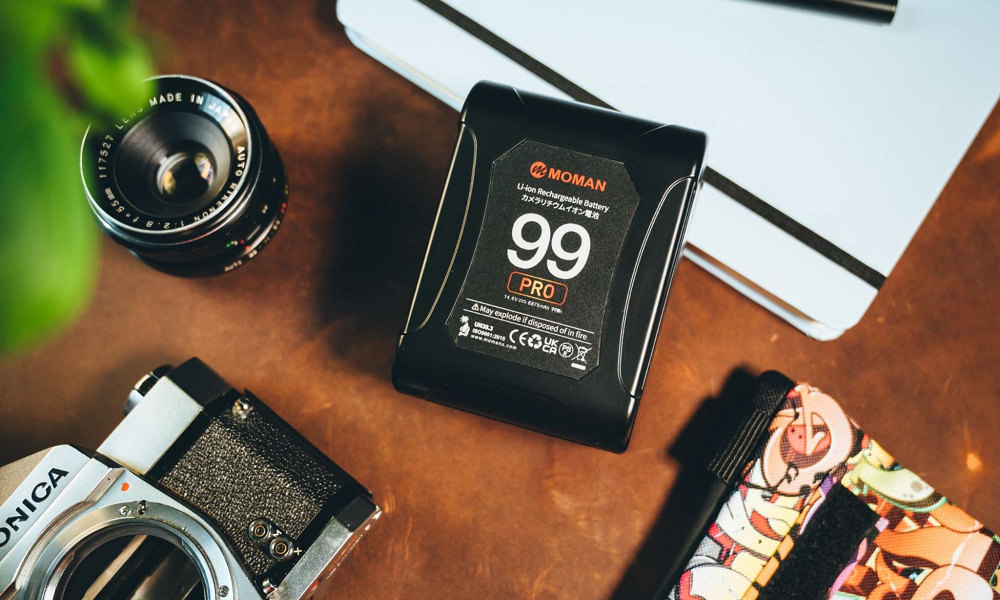Reviews
Beginner guide to mini V-mount battery

Portable power has become essential in modern video and photography production. The mini V-mount battery offers professionals and creators a smaller, lighter, and smarter power solution that fits the pace of today’s mobile workflows. It brings the same reliability as traditional V mount batteries but in a compact form suitable for on-the-go shooting. This article explains what it is, how it works, and how to choose the right one for your gear.
What is a mini V-mount battery?
A mini V-mount battery is a scaled-down version of the standard V mount power pack used in professional film and broadcast setups. It maintains the same V-shaped locking interface but reduces size and weight dramatically. With capacities typically between 45Wh and 155Wh, these batteries can power cameras, LED lights, and wireless transmitters for hours while keeping your rig lightweight.
The compact form factor makes it ideal for handheld setups, stabilizers, or travel productions. Despite its small body, it still delivers consistent voltage and professional-grade reliability. In short, it gives you a lot of power in a portable size.
How does a compact V-mount battery work?
The mini V-mount battery connects through a V-shaped locking plate, ensuring a secure and quick mount to your device or rig. It supplies a steady DC voltage, usually around 14.4V, which is compatible with most cameras and accessories.
Modern models integrate smart chips that monitor power levels, temperature, and charging status. Many also include USB-C and D-Tap outputs, allowing users to charge multiple devices simultaneously. This multi-port design lets a single battery power a camera, monitor, and wireless receiver all at once – an efficient setup for solo creators or small crews.
What makes it different from a regular V-mount battery?
The biggest difference lies in mobility and flexibility. Standard V-mount batteries are made for high-power studio cameras, while mini versions focus on versatility. A mini V-mount battery fits smaller cages, balances well on gimbals, and reduces fatigue during long handheld shooting sessions.
It’s a preferred choice for documentary filmmakers, travel vloggers, and independent creators who move frequently between locations. Though smaller, it still delivers stable output, making it a perfect middle ground between portability and performance.
How to choose the best mini V-mount battery
Choosing the best mini-V mount battery depends on your shooting needs and gear setup. Here are several factors to consider before purchasing:
1. Capacity and runtime
Battery capacity, measured in watt-hours (Wh), directly affects how long it can power your equipment. For mirrorless cameras or small LED lights, a 99Wh V-mount battery is usually enough. For longer sessions or multiple devices, choose 100–150Wh models. Always balance runtime with weight – more power means heavier packs.
2. Output options
Check how many ports your battery offers. Models with USB-C output allow you to charge phones, tablets, or monitors, while D-Tap ports can power cameras and transmitters. Some versions even include dual D-Tap outputs for multi-device setups. The more versatile the ports, the more efficient your workflow.
3. Compatibility and mounting
Ensure your battery and V mount battery plate are compatible. Some batteries are designed specifically for V mount batteries for DSLR systems or compact rigs, while others suit large cinema cameras. Compatibility guarantees stable connection and safe power delivery.
4. Build quality and safety
A reliable battery should have durable housing and built-in protection against short circuits, overcharging, and overheating. Choose brands that list safety certifications and transparent v-mount battery price ranges, as extremely cheap options may compromise safety standards.
5. Portability
If you often shoot on the go, portability is crucial. Look for a lightweight, mini V mount battery with USB-C for flexible charging. Compact, travel-friendly models keep your kit organized and reduce setup time, especially in field productions.
How to use a mini V-mount battery plate
To connect your mini battery safely, you’ll need a mini V-mount battery plate. This plate acts as a power hub, offering multiple output ports such as D-Tap, DC, or USB-C. It can be mounted to camera cages, tripods, or shoulder rigs depending on your setup.
When installing, make sure the plate locks firmly and cables are neatly arranged. Poor connections can lead to unstable voltage or sudden shutdowns during shooting. Some plates even include built-in voltage displays or charging indicators, adding extra convenience during long production days.
How to charge mini V mount battery safely
Knowing how to charge a mini V-mount battery properly helps extend its life and ensures consistent performance. Always use a compatible V mount charger or a power adapter approved by the manufacturer. Avoid using uncertified chargers that could cause overheating or shorten the battery lifespan.
If your model supports USB-C PD charging, you can conveniently top up power using a laptop adapter or power bank while traveling. Avoid charging in high temperatures or leaving the battery plugged in overnight. For long-term storage, keep it around 50% charged and in a cool, dry environment. Proper maintenance ensures stable output and a longer service life.
Final thoughts
The mini V-mount battery is a perfect blend of portability, power, and professional performance. It gives creators the ability to run multiple devices without relying on bulky power sources. By understanding how it works and learning how to choose and maintain it properly, you can get the most out of every shoot.
Whether in a studio or on the road, this compact battery type continues to reshape how modern filmmakers power their creative tools – making it an essential part of every efficient production setup.

-

 World1 week ago
World1 week agoEthiopian volcano erupts for first time in thousands of years
-

 Health1 day ago
Health1 day ago8 kittens die of H5N1 bird flu in the Netherlands
-

 Legal6 days ago
Legal6 days agoUtah Amber Alert: Jessika Francisco abducted by sex offender in Ogden
-

 US News5 days ago
US News5 days agoExplosion destroys home in Oakland, Maine; at least 1 injured
-

 Health6 days ago
Health6 days agoMexico’s September human bird flu case confirmed as H5N2
-

 Legal3 days ago
Legal3 days ago15 people shot, 4 killed, at birthday party in Stockton, California
-

 World6 days ago
World6 days agoWoman killed, man seriously injured in shark attack on Australia’s NSW coast
-

 Health5 days ago
Health5 days agoMarburg outbreak in Ethiopia rises to 12 cases and 8 deaths




